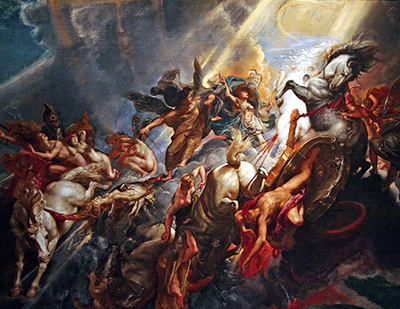Peter Paul Rubens makes full use of his delicate handling of light in this 1605 painting titled The Fall of Phaeton
The ancient Greek myth of Phaeton (Phaethon) has been used as inspiration for artists from all manner of art movements, particularly in the Renaissance and Baroque periods. Zeus aims thunderbolts at Phaeton and this provides the source for Rubens to add stripes of light that cut diagonally across the canvas.
Rubens uses these lightning bolts to specifically focus the viewer's eyes on the facial expressions of the key figures in this complex composition. This abrupt use of light is similar to the paintings of Caravaggio and Rembrandt, where as in later centuries there would be a far more subtle blending of light from the likes of Claude Monet and other members of the Impressionist movement.
Rubens produced work in different countries around Europe during his career, with this painting coming from his time in Rome, Italy. He would later rework it in 1606/1608 although it has proven difficult for art historians to be too precise around events which occurred so many centuries ago. The Fall of Icarus, Perseus Freeing Andromeda and The Judgement of Paris are other fine examples of Rubens work with Greek mythology.
The stunning original artwork, whose size is an impressive 98.4cm × 131.2cm, can now be found at the National Gallery of Art, Washington DC in the United States. This prestigious North American gallery includes The Annunciation by Jan van Eyck, Ginevra de Benci by Leonardo da Vinci, Laocoon by El Greco plus a world famous self portrait by Rembrandt. Their extraordinary collections goes well beyond just these highlights, ranking amongst the best in any North American institution.
Michelangelo famously produced a drawing on The Fall of Phaeton. This Renaissance master consistently took on religious themes in a multiple of different mediums, most notably drawing, painting and sculpture.




